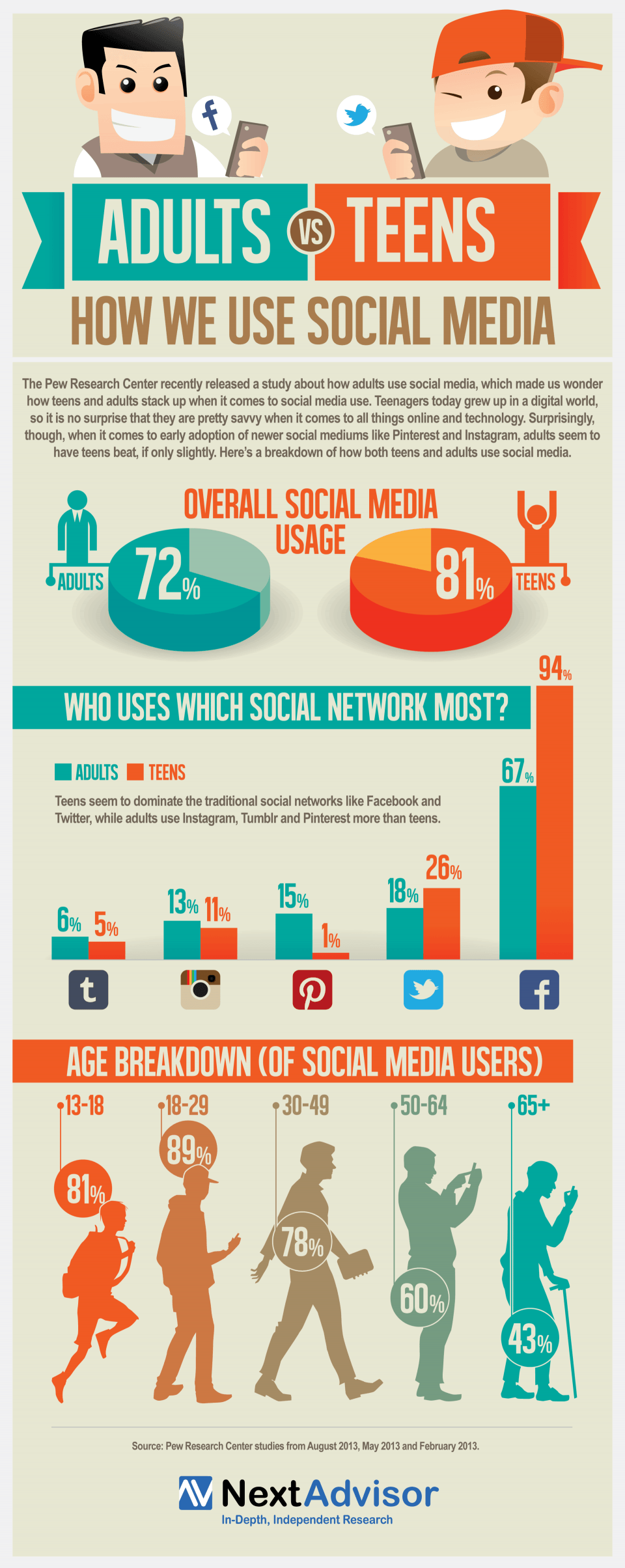
Adults vs. Teens: How Different Generations Use Social Media
The advent of social media has significantly transformed how individuals across generations interact, communicate, and consume information. The Pew Research Center’s study, highlighted in this infographic, dives into the nuanced differences between adults and teens when it comes to social media usage, revealing insights that illustrate how each group utilizes these platforms in their daily lives.
Overall Social Media Usage
Social media penetration has become ubiquitous across both age groups, but teens slightly edge out adults in overall usage. The data shows that 81% of teens use social media compared to 72% of adults. This difference, while not huge, reflects how deeply integrated social media is in the lives of teenagers, who have grown up in the digital age.
For adults, the rise of social media came during their adult lives, meaning they had to adopt it as a new form of communication. Conversely, for teens, social media is ingrained in their cultural fabric. This explains why teens lead the way in terms of overall adoption, as they are more likely to explore new platforms and make it a central part of their social interactions.
Who Uses Which Social Networks the Most?
A closer look at specific platforms shows stark contrasts between adults and teens regarding their preferences.
- Facebook remains the dominant platform among adults, with 67% of adults reporting it as their primary social network, compared to only 26% of teens. This platform’s appeal to adults likely stems from its utility as a way to stay in touch with friends and family, particularly for older users.
- Teens are more inclined to use platforms like Instagram (11% of teens versus 13% of adults) and Twitter (18% of teens versus 15% of adults). For teens, Instagram offers a visually driven space for self-expression, while Twitter’s rapid flow of information may cater to their desire for real-time updates and trends.
- Interestingly, adults have adopted Pinterest more than teens, with 15% of adults using the platform compared to only 1% of teens. This can be attributed to Pinterest’s appeal for activities like crafting, home decor, and recipe curation—areas typically more relevant to adults.
- Tumblr use is relatively niche, with 6% of adults and 5% of teens engaging on the platform. While Tumblr’s user base may be smaller, it serves as a space for more specific, often subcultural content that can appeal to users looking for a different type of social interaction.
Age Breakdown of Social Media Users
Breaking down the age groups within social media users presents another layer of understanding:
- Teens aged 13-18 boast a significant 81% social media usage, reflecting their deep entrenchment in digital communication.
- Young adults aged 18-29 show the highest usage rate at 89%, confirming that this age group—many of whom were teenagers during the rise of social media—has seamlessly integrated these platforms into their lives.
- Adults aged 30-49 have a robust 78% engagement with social media, underscoring the increasing relevance of these platforms for middle-aged users, often for networking, staying informed, or maintaining personal connections.
- Those in the 50-64 age group show a decline in usage with 60% active on social media. This reflects the challenges of later adoption, but still indicates a significant presence, likely fueled by platforms like Facebook.
- For seniors 65+, the percentage drops to 43%. This group tends to use social media more sparingly, often for staying in touch with family rather than broader interaction.
Why These Differences Matter
The differences in social media use between adults and teens underscore how generational cohorts adopt and adapt to new technologies. Teens, having grown up in an era where social media is the norm, naturally integrate these platforms into their daily lives, using them for communication, entertainment, and self-expression. Adults, on the other hand, approach social media with different priorities, often using it for professional purposes, news consumption, or staying in touch with broader social networks.
Understanding these nuances is critical for businesses, marketers, and social media platforms themselves as they tailor their content and user experiences to the preferences of each demographic. While teens are likely to gravitate toward visually driven and trend-sensitive platforms like Instagram or TikTok (though not shown in this data), adults may continue to dominate the more traditional spaces of Facebook and Pinterest.
Conclusion
The infographic paints a clear picture of how social media usage diverges between adults and teens, offering insights into not only the platforms themselves but also the underlying motivations of their users. As social media continues to evolve, these trends may shift, but the generational differences in how we engage with these platforms will likely persist, reflecting broader shifts in communication, culture, and technology.







